Tech
Be a good example
Published
4 years agoon
By
Terry Power
Then I tried, up front, telling the boys what I didn’t want to talk about. But they wouldn’t listen.
Our father said teenage boys were always like this. It was nothing new.
Thoughts. Sierra Kidd is my sister. I am her Older Sibling. My name is Kim, what is yours? My age is 15. This thing is called a plane. A plane. The water down there is called the Pacific Ocean. Programmable age is 15. Bethany and Robert Kidd are my parents. Mom and Dad. I look like people, but I am me. Mom and Dad might want me to call them Bethany and Robert, and if so, that is not a reflection of negative feelings. People change their minds. Preferences make people individuals. This thing is called a plane. Drink water, the attendants tell us. Drink, drink. All the time. Stay lubricated. You do not want to get squeaky, because squeaky is disruptive. Squeak, squeak, they say, in a different voice than before. And now they smile. I look out the window. That is land. I am smiling.
“What do you want to be?” Kim asked me. I was six or seven, in bed, and she was crouched down to my eye level. Her hands gripped the edge of the mattress as if a cliff’s edge.
“Astronaut,” I said.
Her eyes widened. “That’s new.”
A few days before we’d watched the shuttle Discovery carry the Hubble Space Telescope into orbit. On the couch with me, her arms raised as she braided her hair, she’d gasped when the shuttle lifted from the launch pad. It wasn’t the first time a launch had been on TV, but Kim seemed to recognize something new. Even as young as I was, I knew to expect a change. She was adapting all the time.
It came a few nights later. She said, “I want to be an astronaut too.” I blinked hard, her face so large and close to my own. We both had green eyes, dark hair, a dimple in our chin. Freckles. Wanting to be something was new.
Little Sierra. Hold hands. Don’t worry. Sleeping baby, two years old, likes bananas, dry cereal, smells like milk, soft skin, softest behind ear and back of neck. I am welcome and trusted, because I am a good example, and I am one of the first of me, and the more I learn, the more I am. The first Saturday of every month, at the coffee shop in Georgetown, the Older Siblings meet. There are so many of us that we push six tables together. Pam says, The more I remember, the more I remember. We don’t like this as much as Tim saying The more I learn, the more I am. People in the coffee shop think we are interesting. We smile back at them. Be a good example. The Older Siblings ask each other, What do you do with your child? And I say, We sing, we dance, we nap. Not everyone has thought of dancing yet, so I pretend to hold little Sierra’s hands, and I move from foot to foot. No, Pam says, I know what dancing is, but I had not thought about it as an activity to do with my child. The group looks at me. We know what dancing is, Tim says. I let go of invisible Sierra’s hands and I sit. Pam says, The more I remember, the more I remember. She says, When my battery gets very low, I remember more. I am remembering people in another place. Tim asks, Who are the people? But Pam doesn’t know. Tim asks, What is the place? Pam says the place is bright and noisy and she does not know.
I met my husband in my mid-30s, after three therapists, two attempts at God (the first Lutheran, the other the AA kind), countless attempts to quit drinking, and two suicide attempts. After all that, more rehab and meetings. Memorization of adages became actual acceptance. Things clicked. I thought I might become a social worker.
The man who became my husband was first the admissions counselor for graduate school. I told him I wanted to turn my trauma into service. He didn’t flinch. In fact, he said social work was a common trajectory for people so experienced with recovery.
On our first date, he held my hand as we crossed the Memorial Bridge at rush hour. The air was strong with exhaust and something rotten from the river, but my whole body was alive, as if a switch had flipped. The warm night, even warmer in the joined palms of our hands. It’d been so long since anyone had reached for me. Casual intimacy punctuated with perfunctory questions. All the things people think they need to know about each other.
“What do your parents do?” he asked.
“They were researchers. Robotics.”
“Any siblings?”
“No,” I said. “You?”
Beautiful Sierra. Smart Sierra. I wait for Tim to finish showing the group the same photos of his child. It is a bad sign. His child is two years older than the photos he shows. Here, Sierra in her blue and silver dance uniform. Here, Sierra practices the saxophone in her bedroom. The group passes around my photos. I have missed the last two meetings, because summer is busy. Summer is camp. I do not have camp photos yet, but the group understands. No one else has photos. We drink water. Tim says, Has anyone seen Pam? No one has seen Pam. She is the second one to stop coming to the coffee shop. I don’t say so, but I saw Pam’s child at camp. Pam was not at camp, though.
At the end of middle school, our parents sat us down and explained that Kim would be enrolled as a high school freshman alongside me.
“You’re not a companion anymore,” our mother said. “Instead, we’d like you to be a teenager.”
“You’ve earned it,” our father said.
I shifted on the couch next to Kim and in my peripheral saw her hands move into her lap and clasp. She was always listening closely, but this was her pose for demonstrating it.
“From now on,” our mother said, “You’ll have a birthday. Next year, you’ll be 16.”
“My programmable age will be 16?”
“Sure,” our father said. “The point is, Sierra can handle herself now. She can be responsible for her days.”
Sleeping baby, two years old, likes bananas, dry cereal, smells like milk, soft skin, softest behind ear and back of neck.
Kim turned to me. So often in our lives I felt I could read her mind by watching her face, but not now. All I saw was the slow processing of new information.
I shrugged. “No one I know has an Older Sibling anymore.”
Sophomore year I tried out for the swim team. The other girls seemed serious and confident in a way I admired. There’s something self-assured about throwing yourself headfirst into a thing that can’t really catch you.
I came up from the final lap, gasping at the wall, and there was Kim in her own suit. Smiling, looking alien in a swim cap. The coach signaled for the next group. Kim leapt from the starting block, arcing long and effortlessly over my head, and entered the water. When she did not surface, I ducked under. Her body cruised all nine feet to reach the bottom.
I tried volleyball instead, debate team, student council, track. It wasn’t only that Kim followed me each time. I couldn’t quite make a place for myself anywhere. I floated, sat near the edges of tables and rooms, entered last, departed first. This is when the drinking started: those kids were my people, I guess, though we knew little about each other’s home life. We only knew there was something about each of us that didn’t quite work in the normal world.
I turned away from Kim in the halls. She registered for different classes because I told her I was in them. She waited near my locker, repeated my name as she stood behind me in the lunch line, waved across the parking lot as I got in a friend’s car.
At home, I could be all hers. But in school, I silently chanted, Just adapt already, please, please, just adapt.
In the spring, I saw her across the quad. One among a gaggle in shining red nylon uniforms, cutting through the overgrown grass toward the track. I saw another girl hand her something. Kim swept her hair back into a ponytail. A hair tie.
EMILY LUONG
“Is this okay?” Brandon asked. It was later that same day. Our bodies brushed against each other underneath the blankets. Naked except for our socks. His basement bedroom had cinderblock walls, the room cool and silent.
“Do you have a condom?” I asked. Among the group, until then, we’d hardly spoken. He wore the same three Nirvana T-shirts. His arms were nicked with scrapes and scars from skateboarding.
I trembled the whole way, my body out of my control, and he kept asking if I was okay, and I said yes, then I said stop asking, then I stopped answering. When it was over, I abruptly fell asleep.
Kim in my dreams. She and the track team running through a field, ponytails whipping. I couldn’t tell which was her.
I run and run, but I slow down. Practice. But I slow down. Ralph in the grass, stretching muscles. His hands. Hold hands. I finish the last lap. The coach says, Good going, K. And I go to the concession stand, which is closed, but I am allowed to use the plug with the surge protector next to the deep freezer. I charge. My heart rattling. I breathe and breathe. I slide open the window, which is for customers, but the stand is closed so there are no customers, and I watch the next practice sprint. I hear people shouting. I see Ralph on the track. He finishes first and goes to the cooler by the bleachers and dumps a cup of water over his head. He shines. He waves to me. He comes over. He reaches his hand into the window. Hold hands. That is that. That is that thing. Whoa, Ralph says. I can feel, like, your electricity.
“What do you want to be?” Kim asked me. I was 11. We were on the monkey bars at the park near our house, each of us swinging from opposite ends to meet in the middle.
“A news reporter,” I told her.
“That’s new,” she said. “Mom says Older Siblings would make ideal astronauts.”
We hung there, face to face. I was supposed to say something, but I didn’t want to, and I wasn’t sure why.
She started again. “Mom says—”
I wrapped my legs around her waist and let go, wrenching both of us down to the dirt. It shocked the wind from my chest. “Breathe,” Kim instructed. When I inhaled and sat up, we both stared at the odd backward bend in her left wrist. She raised her arm. The hand flopped forward. There was a quiet buzzing coming from somewhere. She raised the hand to listen, and put it up to my ear next. A small, furious sound.
“Does it hurt?”
“No pain,” Kim said.
I checked the benches on the other side of the playground, several yards away. Two women in khaki shorts and polos watched us and made notes, one on a clipboard, the other dictating into a small recorder. Sometimes they brought a video camera. Our mother said they were her coworkers. “You’ve met them,” she said. “They’ve been to the house. Remember your dad’s surprise party?”
“Any siblings?” “No,” I said. “You?”
Looking at the women that day, I felt unsteady and strange. The women were adults, but neither came forward to help or scold. They watched us, waiting.
I threw my arms around Kim’s neck. “I’m really sorry,” I said. My remorse was real. But I also knew that I had to demonstrate it.
“How’s it going?” our parents would ask me. They meant Kim and me and high school. They meant data worth reporting.
“You have to get her to stop following me around,” I said.
“She’ll adapt,” they said. “And it’s okay if she doesn’t. We need to know that, too.”
“This isn’t fair,” I said.
“She held you as a baby, Sierra. You want us to send her back? She’ll be put in storage.”
I didn’t know what storage looked like, or where it was, but I pictured darkness. Constriction. Regulated cold. Last thought unfinished, not even echoing, gone from time. The mention of storage always stopped the conversation.
Ralph says, You’re really real. Ralph says, I love you. Ralph says, Pray with me, Kim. My parents won’t let us be together anymore. I pray, but I don’t know. I am trying to know. They call me doll slut and ask me if I like how it tastes. I don’t know God, I know people. Too difficult. No thoughts. I run until Coach says, Stop, K. You’re shaking. You need to—Sierra—Sierra—Sierra is my sister, I am older. I am older. Hold hands. Coach holds my hand, his face is close. Coach says, Kim, can you hear me? Hand squeezes hand. Kim, you fainted. Or, I don’t know? Warm. Grass. Dirt. Sky. Sierra—Sierra—Sierra. I remember—I remember—the plane. I remember the plane. No. Before.
With my husband, the beginning was the best. The tender, stuttering attempts at togetherness. Helping each other cook. Choosing a DVD. Brewing coffee in the morning. Driving, one of his hands on the wheel, the other on my thigh. Still, the moments between were hard for me. I felt I’d given him everything, up front, that first time I sat across from him in his office on campus. I could understand wanting to know more, but I preferred being in bed. The questions were easier.
“You never ask me anything,” he said, after, his mouth against my neck. He smelled of mint and garlic from dinner. His heart hammering at my back.
One night when our parents were away, I was home watching TV and waiting for the bleach to set in my hair when I heard Kim collapse upstairs. The bathroom door was unlocked. I found her on the floor, the hairbrush still gripped in her hand. This is not serious, I told myself, though it had never happened before.
Contradiction slowed my thoughts—a body on the floor, but no, not really a body on the floor. Her battery is too low. She is not hurt. I told myself these things to quell the panic as I gripped under her armpits and dragged her across the hall.
In her bedroom, I put her on the floor next to her bed, flipped her hair over her face, and plugged the power cord into the three-pronged gap behind her ear. The lights flickered. I heard the TV downstairs suddenly pop and go silent.
She hummed. I crawled onto her bed and laid on my stomach along the edge. I wanted to see the moment she came back.
“Sierra. Sssss-airrruh. Ssss-sss …”
Her voice sounded like air. I hated hearing it like that.
“You’re okay,” I told her. “You’re charging.” I held her hand. Her body hummed. I’d never heard it so loud before, like a refrigerator.
The more I remember, the more I remember.
When she could speak, she told me about a dream. A bright and noisy place. She said the voices were kind, but hard to understand. I nodded along. She’d never told me a dream before. I didn’t even know she had them. In it, she couldn’t feel her legs or arms, but she felt cold air on her head, the sense of being exposed. Then the dream switched to a long hallway. She could feel her legs now. Around her stood several people. A small woman with dark hair waved her hands, saying, Come, come. You can do it. Good boys and girls, come, come.
“I thought you couldn’t understand the people?”
“Oh.” Kim laughed. “I was wrong.”
“That’s dream logic,” I said. “Things that don’t make sense in real life are suddenly not a problem.”
“Dream logic,” Kim repeated, then: “Drink water. Drink, drink.”
“You want water?” I asked.
“Pam was right.”
“Who’s Pam?”
“The more I remember, the more I remember.”
She closed her eyes. Her hand remained in mine. Eventually I fell asleep, forgot all about the bleach. I woke up with my scalp burning and clumps of hair on the bedspread: I had to shave my head.
I go to the coffee shop. I have no pictures. I have not been to the coffee shop in a long time. I ask the new Pam, Have you seen Tim? She says, I do not know Tim. I say, The more I learn, the more I am. She blinks. Then I say, The more I remember, the more I remember. I say it twice. But the new Pam shakes her head. I don’t understand, she says. What is your child’s name?
I attended a small, women-only liberal arts college a few hours away. Surrounded by woods and mountains, I didn’t know anyone, and no one knew me. The other girls with shaved heads felt my scalp in appreciation. Everyone was different in the same ways. Nose piercings, hairy legs, bumper stickers about tolerance and revolution. The social groups were porous and the acceptance was surreal. Drinking became about socializing, not hiding or waiting to escape.
Back home, our parents got Kim a job as a receptionist in a dentist’s office. Sometimes she called me from work, leaving messages about the number of root canals that day or the little kids having their first cleaning. She was telling me about her life. I knew the implication—she wanted to hear about mine. But I never called.
Our parents told me they’d found her unconscious a few times. Her battery too low. Once she’d even passed out during dinner, slumping to the floor in the middle of a sentence.
“She needs your engagement,” our mother said. “We’re putting her on a bus.”
You may like
-


This UK startup engineered a clever way to reuse waste heat from cloud computing
-


Good governance essential for enterprises deploying AI
-


Is Sparkling Water Really Good For Health? Here’s What Experts Think
-


How Good Posture Eliminates Postural Discomfort and Relieves Self-Confidence
-


Good News For People With Chronic Back Pain – New Treatment Could Offer ‘Dramatic’ Relief
-


Banning ChatGPT will do more harm than good

My senior spring in high school, I decided to defer my MIT enrollment by a year. I had always planned to take a gap year, but after receiving the silver tube in the mail and seeing all my college-bound friends plan out their classes and dorm decor, I got cold feet. Every time I mentioned my plans, I was met with questions like “But what about school?” and “MIT is cool with this?”
Yeah. MIT totally is. Postponing your MIT start date is as simple as clicking a checkbox.
COURTESY PHOTO
Now, having finished my first year of classes, I’m really grateful that I stuck with my decision to delay MIT, as I realized that having a full year of unstructured time is a gift. I could let my creative juices run. Pick up hobbies for fun. Do cool things like work at an AI startup and teach myself how to create latte art. My favorite part of the year, however, was backpacking across Europe. I traveled through Austria, Slovakia, Russia, Spain, France, the UK, Greece, Italy, Germany, Poland, Romania, and Hungary.
Moreover, despite my fear that I’d be losing a valuable year, traveling turned out to be the most productive thing I could have done with my time. I got to explore different cultures, meet new people from all over the world, and gain unique perspectives that I couldn’t have gotten otherwise. My travels throughout Europe allowed me to leave my comfort zone and expand my understanding of the greater human experience.
“In Iceland there’s less focus on hustle culture, and this relaxed approach to work-life balance ends up fostering creativity. This was a wild revelation to a bunch of MIT students.”
When I became a full-time student last fall, I realized that StartLabs, the premier undergraduate entrepreneurship club on campus, gives MIT undergrads a similar opportunity to expand their horizons and experience new things. I immediately signed up. At StartLabs, we host fireside chats and ideathons throughout the year. But our flagship event is our annual TechTrek over spring break. In previous years, StartLabs has gone on TechTrek trips to Germany, Switzerland, and Israel. On these fully funded trips, StartLabs members have visited and collaborated with industry leaders, incubators, startups, and academic institutions. They take these treks both to connect with the global startup sphere and to build closer relationships within the club itself.
Most important, however, the process of organizing the TechTrek is itself an expedited introduction to entrepreneurship. The trip is entirely planned by StartLabs members; we figure out travel logistics, find sponsors, and then discover ways to optimize our funding.

COURTESY PHOTO
In organizing this year’s trip to Iceland, we had to learn how to delegate roles to all the planners and how to maintain morale when making this trip a reality seemed to be an impossible task. We woke up extra early to take 6 a.m. calls with Icelandic founders and sponsors. We came up with options for different levels of sponsorship, used pattern recognition to deduce the email addresses of hundreds of potential contacts at organizations we wanted to visit, and all got scrappy with utilizing our LinkedIn connections.
And as any good entrepreneur must, we had to learn how to be lean and maximize our resources. To stretch our food budget, we planned all our incubator and company visits around lunchtime in hopes of getting fed, played human Tetris as we fit 16 people into a six-person Airbnb, and emailed grocery stores to get their nearly expired foods for a discount. We even made a deal with the local bus company to give us free tickets in exchange for a story post on our Instagram account.
Tech
The Download: spying keyboard software, and why boring AI is best
Published
2 years agoon
22 August 2023By
Terry Power
This is today’s edition of The Download, our weekday newsletter that provides a daily dose of what’s going on in the world of technology.
How ubiquitous keyboard software puts hundreds of millions of Chinese users at risk
For millions of Chinese people, the first software they download onto devices is always the same: a keyboard app. Yet few of them are aware that it may make everything they type vulnerable to spying eyes.
QWERTY keyboards are inefficient as many Chinese characters share the same latinized spelling. As a result, many switch to smart, localized keyboard apps to save time and frustration. Today, over 800 million Chinese people use third-party keyboard apps on their PCs, laptops, and mobile phones.
But a recent report by the Citizen Lab, a University of Toronto–affiliated research group, revealed that Sogou, one of the most popular Chinese keyboard apps, had a massive security loophole. Read the full story.
—Zeyi Yang
Why we should all be rooting for boring AI
Earlier this month, the US Department of Defense announced it is setting up a Generative AI Task Force, aimed at “analyzing and integrating” AI tools such as large language models across the department. It hopes they could improve intelligence and operational planning.
But those might not be the right use cases, writes our senior AI reporter Melissa Heikkila. Generative AI tools, such as language models, are glitchy and unpredictable, and they make things up. They also have massive security vulnerabilities, privacy problems, and deeply ingrained biases.
Applying these technologies in high-stakes settings could lead to deadly accidents where it’s unclear who or what should be held responsible, or even why the problem occurred. The DoD’s best bet is to apply generative AI to more mundane things like Excel, email, or word processing. Read the full story.
This story is from The Algorithm, Melissa’s weekly newsletter giving you the inside track on all things AI. Sign up to receive it in your inbox every Monday.
The ice cores that will let us look 1.5 million years into the past
To better understand the role atmospheric carbon dioxide plays in Earth’s climate cycles, scientists have long turned to ice cores drilled in Antarctica, where snow layers accumulate and compact over hundreds of thousands of years, trapping samples of ancient air in a lattice of bubbles that serve as tiny time capsules.
By analyzing those cores, scientists can connect greenhouse-gas concentrations with temperatures going back 800,000 years. Now, a new European-led initiative hopes to eventually retrieve the oldest core yet, dating back 1.5 million years. But that impressive feat is still only the first step. Once they’ve done that, they’ll have to figure out how they’re going to extract the air from the ice. Read the full story.
—Christian Elliott
This story is from the latest edition of our print magazine, set to go live tomorrow. Subscribe today for as low as $8/month to ensure you receive full access to the new Ethics issue and in-depth stories on experimental drugs, AI assisted warfare, microfinance, and more.
The must-reads
I’ve combed the internet to find you today’s most fun/important/scary/fascinating stories about technology.
1 How AI got dragged into the culture wars
Fears about ‘woke’ AI fundamentally misunderstand how it works. Yet they’re gaining traction. (The Guardian)
+ Why it’s impossible to build an unbiased AI language model. (MIT Technology Review)
2 Researchers are racing to understand a new coronavirus variant
It’s unlikely to be cause for concern, but it shows this virus still has plenty of tricks up its sleeve. (Nature)
+ Covid hasn’t entirely gone away—here’s where we stand. (MIT Technology Review)
+ Why we can’t afford to stop monitoring it. (Ars Technica)
3 How Hilary became such a monster storm
Much of it is down to unusually hot sea surface temperatures. (Wired $)
+ The era of simultaneous climate disasters is here to stay. (Axios)
+ People are donning cooling vests so they can work through the heat. (Wired $)
4 Brain privacy is set to become important
Scientists are getting better at decoding our brain data. It’s surely only a matter of time before others want a peek. (The Atlantic $)
+ How your brain data could be used against you. (MIT Technology Review)
5 How Nvidia built such a big competitive advantage in AI chips
Today it accounts for 70% of all AI chip sales—and an even greater share for training generative models. (NYT $)
+ The chips it’s selling to China are less effective due to US export controls. (Ars Technica)
+ These simple design rules could turn the chip industry on its head. (MIT Technology Review)
6 Inside the complex world of dissociative identity disorder on TikTok
Reducing stigma is great, but doctors fear people are self-diagnosing or even imitating the disorder. (The Verge)
7 What TikTok might have to give up to keep operating in the US
This shows just how hollow the authorities’ purported data-collection concerns really are. (Forbes)
8 Soldiers in Ukraine are playing World of Tanks on their phones
It’s eerily similar to the war they are themselves fighting, but they say it helps them to dissociate from the horror. (NYT $)
9 Conspiracy theorists are sharing mad ideas on what causes wildfires
But it’s all just a convoluted way to try to avoid having to tackle climate change. (Slate $)
10 Christie’s accidentally leaked the location of tons of valuable art 

Seemingly thanks to the metadata that often automatically attaches to smartphone photos. (WP $)
Quote of the day
“Is it going to take people dying for something to move forward?”
—An anonymous air traffic controller warns that staffing shortages in their industry, plus other factors, are starting to threaten passenger safety, the New York Times reports.
The big story
Inside effective altruism, where the far future counts a lot more than the present

October 2022
Since its birth in the late 2000s, effective altruism has aimed to answer the question “How can those with means have the most impact on the world in a quantifiable way?”—and supplied methods for calculating the answer.
It’s no surprise that effective altruisms’ ideas have long faced criticism for reflecting white Western saviorism, alongside an avoidance of structural problems in favor of abstract math. And as believers pour even greater amounts of money into the movement’s increasingly sci-fi ideals, such charges are only intensifying. Read the full story.
—Rebecca Ackermann
We can still have nice things
A place for comfort, fun and distraction in these weird times. (Got any ideas? Drop me a line or tweet ’em at me.)
+ Watch Andrew Scott’s electrifying reading of the 1965 commencement address ‘Choose One of Five’ by Edith Sampson.
+ Here’s how Metallica makes sure its live performances ROCK. ($)
+ Cannot deal with this utterly ludicrous wooden vehicle.
+ Learn about a weird and wonderful new instrument called a harpejji.
Tech
Why we should all be rooting for boring AI
Published
2 years agoon
22 August 2023By
Terry Power
This story originally appeared in The Algorithm, our weekly newsletter on AI. To get stories like this in your inbox first, sign up here.
I’m back from a wholesome week off picking blueberries in a forest. So this story we published last week about the messy ethics of AI in warfare is just the antidote, bringing my blood pressure right back up again.
Arthur Holland Michel does a great job looking at the complicated and nuanced ethical questions around warfare and the military’s increasing use of artificial-intelligence tools. There are myriad ways AI could fail catastrophically or be abused in conflict situations, and there don’t seem to be any real rules constraining it yet. Holland Michel’s story illustrates how little there is to hold people accountable when things go wrong.
Last year I wrote about how the war in Ukraine kick-started a new boom in business for defense AI startups. The latest hype cycle has only added to that, as companies—and now the military too—race to embed generative AI in products and services.
Earlier this month, the US Department of Defense announced it is setting up a Generative AI Task Force, aimed at “analyzing and integrating” AI tools such as large language models across the department.
The department sees tons of potential to “improve intelligence, operational planning, and administrative and business processes.”
But Holland Michel’s story highlights why the first two use cases might be a bad idea. Generative AI tools, such as language models, are glitchy and unpredictable, and they make things up. They also have massive security vulnerabilities, privacy problems, and deeply ingrained biases.
Applying these technologies in high-stakes settings could lead to deadly accidents where it’s unclear who or what should be held responsible, or even why the problem occurred. Everyone agrees that humans should make the final call, but that is made harder by technology that acts unpredictably, especially in fast-moving conflict situations.
Some worry that the people lowest on the hierarchy will pay the highest price when things go wrong: “In the event of an accident—regardless of whether the human was wrong, the computer was wrong, or they were wrong together—the person who made the ‘decision’ will absorb the blame and protect everyone else along the chain of command from the full impact of accountability,” Holland Michel writes.
The only ones who seem likely to face no consequences when AI fails in war are the companies supplying the technology.
It helps companies when the rules the US has set to govern AI in warfare are mere recommendations, not laws. That makes it really hard to hold anyone accountable. Even the AI Act, the EU’s sweeping upcoming regulation for high-risk AI systems, exempts military uses, which arguably are the highest-risk applications of them all.
While everyone is looking for exciting new uses for generative AI, I personally can’t wait for it to become boring.
Amid early signs that people are starting to lose interest in the technology, companies might find that these sorts of tools are better suited for mundane, low-risk applications than solving humanity’s biggest problems.
Applying AI in, for example, productivity software such as Excel, email, or word processing might not be the sexiest idea, but compared to warfare it’s a relatively low-stakes application, and simple enough to have the potential to actually work as advertised. It could help us do the tedious bits of our jobs faster and better.
Boring AI is unlikely to break as easily and, most important, won’t kill anyone. Hopefully, soon we’ll forget we’re interacting with AI at all. (It wasn’t that long ago when machine translation was an exciting new thing in AI. Now most people don’t even think about its role in powering Google Translate.)
That’s why I’m more confident that organizations like the DoD will find success applying generative AI in administrative and business processes.
Boring AI is not morally complex. It’s not magic. But it works.
Deeper Learning
AI isn’t great at decoding human emotions. So why are regulators targeting the tech?
Amid all the chatter about ChatGPT, artificial general intelligence, and the prospect of robots taking people’s jobs, regulators in the EU and the US have been ramping up warnings against AI and emotion recognition. Emotion recognition is the attempt to identify a person’s feelings or state of mind using AI analysis of video, facial images, or audio recordings.
But why is this a top concern? Western regulators are particularly concerned about China’s use of the technology, and its potential to enable social control. And there’s also evidence that it simply does not work properly. Tate Ryan-Mosley dissected the thorny questions around the technology in last week’s edition of The Technocrat, our weekly newsletter on tech policy.
Bits and Bytes
Meta is preparing to launch free code-generating software
A version of its new LLaMA 2 language model that is able to generate programming code will pose a stiff challenge to similar proprietary code-generating programs from rivals such as OpenAI, Microsoft, and Google. The open-source program is called Code Llama, and its launch is imminent, according to The Information. (The Information)
OpenAI is testing GPT-4 for content moderation
Using the language model to moderate online content could really help alleviate the mental toll content moderation takes on humans. OpenAI says it’s seen some promising first results, although the tech does not outperform highly trained humans. A lot of big, open questions remain, such as whether the tool can be attuned to different cultures and pick up context and nuance. (OpenAI)
Google is working on an AI assistant that offers life advice
The generative AI tools could function as a life coach, offering up ideas, planning instructions, and tutoring tips. (The New York Times)
Two tech luminaries have quit their jobs to build AI systems inspired by bees
Sakana, a new AI research lab, draws inspiration from the animal kingdom. Founded by two prominent industry researchers and former Googlers, the company plans to make multiple smaller AI models that work together, the idea being that a “swarm” of programs could be as powerful as a single large AI model. (Bloomberg)
